Table of contents
Cashew nuts ( Anacardium occidentale L.) are never raw due to the manufacturing process. Production requires a lot of manual labor and can be hazardous to health, which is why when buying cashew nuts you should at least look for organic production and trade certificates.
Use in the kitchen
Cashew nuts with their buttery, tender, slightly sweet aroma tempt you to consume them in large quantities. Cashew nuts are used for snacking, in muesli or in salads, curries, pesto, rice, pasta and Asian stir-fried dishes. Finely ground, they are used to make vegan cheese, cashew butter, cashew "milk", sauces or desserts. Cashew nuts (not cashew nuts) are particularly popular with vegans. Other nuts (e.g. walnuts) are better suited for raw foodists, because cashews are not raw due to the way they are produced. They also have an unfavorable fatty acid profile.
Roasted cashews, some of which are salted, spiced or sweetened, are also available commercially.
From a nutritional point of view, we recommend replacing some of the cashews in recipes that contain large amounts of cashews with macadamia nuts, which have a better fatty acid profile. If the taste suits you, ground or crushed hemp, linseed or chia seeds are also suitable.
Vegan recipe for vegetable stir-fry with cashew nuts
Ingredients (4 people): 2 cm ginger, 2 garlic cloves, 1 red chili pepper, 3 tbsp soy sauce, 2 tbsp agave syrup, 2 tbsp rice vinegar (or apple cider vinegar), 75 ml water, 1 tbsp cornstarch, 400 g broccoli, 1 red bell pepper, 1 pak choi, 1 red onion, 1 tbsp refined rapeseed oil, 4 tbsp cashew nuts, 1 spring onion, 3 tbsp sesame seeds.
Preparation: Peel the ginger and garlic and chop finely. Remove the seeds from the red chilli and cut into thin rings. Mix the ginger, garlic, chilli, soy sauce, agave syrup and rice vinegar in a bowl. Mix the water with the cornstarch in a separate bowl and then add to the sauce.
Wash the broccoli, sweet peppers and pak choi. Separate the broccoli florets, cut the stalk and sweet peppers into strips. Chop the pak choi into small pieces. Peel the onion, halve it and cut it into slices. Fry the broccoli in a large frying pan over a medium heat for approx. 5 minutes. Then add the sweet peppers, onion, cashew nuts and pak choi and fry for a further 8-10 minutes. Stir the sauce again as the cornstarch tends to settle. Pour it into the vegetables and simmer gently for 2-3 minutes. Wash the spring onions and cut into thin rings. Sprinkle over the vegetable pan together with sesame seeds and serve. The vegetable pan goes well with rice, couscous or bulgur.
Vegan recipes with cashew nuts can be found under the note: " Recipes that have the most of this ingredient ".
| Not only vegans or vegetarians should read this: Vegans often eat unhealthily. Avoidable nutritional errors. |
Purchasing - Storage
Supermarket chains such as Coop, Migros, Denner, Volg, Spar, Aldi, Lidl, Rewe, Edeka, Billa and Hofer stock the sweet, nutty cashews. In addition to "raw" or "natural" cashews, there are also roasted, salted, caramelized and seasoned cashews - pure or in nut mixes. "Raw" in this case simply means unroasted. Organic supermarkets such as Denn's Biomarkt or Alnatura, health food stores, organic shops and drugstores offer the nuts in organic quality.
Really raw cashews are not available commercially because they are heat-treated after harvesting to deactivate toxic oils in the shell. In addition, the high heat makes it easier to open the very hard shell.
The production process of cashew nuts requires a lot of manual work and takes place under conditions that are harmful to health. When buying cashew nuts, make sure that they are fairly traded products (e.g. Fairtrade) and come from controlled organic cultivation. 14
In the DA-CH countries, cashew nuts are available all year round thanks to long-distance imports. The local season varies depending on the country of cultivation.
The availability of cashew nuts varies depending on the size of the store, catchment area, etc. Our recorded food prices for the DA-CH countries can be found above under the ingredient image - and by clicking on them you can see their development at various suppliers.
Storage tips
Cashew nuts should be stored in a cool, dry place, protected from light and hermetically sealed. Chopped nuts will last a little longer if well sealed in the refrigerator. This will prevent mold formation and premature spoilage due to oxidation. Freezing increases the shelf life to up to 12 months. Spoiled nuts can be recognized by their unpleasant rancid taste. 8
Ingredients - Nutritional values - Calories
Cashew nuts have an energy content of 553 kcal/100g due to their high content of carbohydrates, fats and proteins. 9
From a nutritional point of view, cashews have a very unfavorable fatty acid profile. They contain relatively high levels of omega-6 fatty acids (linoleic acid, LA : 7.8 g/100g = 78% of the daily requirement) and very few omega-3 fatty acids (alpha-linolenic acid, ALA). The LA:ALA ratio is up to 130:1. Peanuts have an even more unfavorable ratio of 160:1. 9
They also provide larger amounts of the essential amino acid tryptophan (0.29 g/100g). Higher amounts are found in sesame (0.39 mg/100g) or unpeeled hemp seeds (0.37 mg/100g). 9
Cashew nuts are rich in manganese with 1.7 mg/100g (83% of daily requirement). Better sources of manganese are hazelnuts (6.2 mg), pumpkin seeds (4.5 mg) and walnuts (3.4 mg). 9
Magnesium is well represented in cashews with 292 mg/100g. In comparison, hemp seeds have 700 mg, linseed 392 mg and sesame 351 mg.
The complete ingredients of cashew nuts, the coverage of the daily requirement and comparison values with other ingredients can be found in our nutrient tables. In the article Nutrients explained you will get a detailed insight into the topic.
Effects on health
Are cashew nuts healthy? Cashew nuts contain more omega-6 fatty acids (linoleic acid, LA) than omega-3 fatty acids (alpha-linolenic acid, ALA). A diet with a high proportion of omega-6 fatty acids (LA) and a low proportion of omega-3 fatty acids (ALA) promotes inflammatory processes, thrombosis and constricts blood vessels and bronchi in the long term. There is also evidence that an unfavorable ratio leads to more atherosclerotic diseases. 2,10 With a western diet, a ratio of 10:1 is normally given. 2
Since the pro-inflammatory LA and the anti-inflammatory ALA use the same enzymes for conversion, they are in direct competition. According to Dr. Michael Greger, the ideal omega-6 to omega-3 ratio would be 1:1 in order to maintain a balance between the two conversion processes in the body. The guidelines of the Federal Nutrition Commission (EEK) are less strict and recommend reducing the ratio to at least 5:1. The smaller the ratio, the higher the conversion rate into the anti-inflammatory, long-chain omega-3 fatty acids ( EPA eicosapentaenoic acid and DHA docosahexaenoic acid). 2,11
Vegans and vegetarians show a ratio of 14:1 to 20:1 or higher - largely because of the popularity of cashews, peanuts, hazelnuts, almonds, sunflower seeds and vegetable oils. 18 Misinformed or uninformed vegans and vegetarians often eat less healthily than normal eaters - and a study is sure to come out that will ruthlessly expose this. This could stop the vegan hype, which is so important for animal welfare and the environment, and discredit the oriented minority. This has been our fear since 2014! Here is the link to what happened with raw food: The Giessen raw food study.
Consume small amounts of omega-6-rich seeds, nuts and vegetable oils and provide your body with sufficient omega-3 fatty acids, e.g. via linseed (22.8 g/100g), chia seeds (17.8 g/100g), walnuts (9.1 g/100g), rapeseed oil (9.1 g/100g), unpeeled hemp seeds (8.7 g/100g), leafy vegetables or herbs. The foods listed are rich in omega-3 fatty acids and/or have a particularly good ratio to omega-6 fatty acids. 2.9
Eating cashews occasionally and in small amounts is not a problem. However, calling them a superfood is misleading because of the unfavorable fatty acid ratio.
Dangers - Intolerances - Side effects
Some people are allergic to cashews. The number of cases increases with the consumption of cashews. Even small amounts can cause allergic reactions, comparable to walnut or peanut allergies. Cross-allergies have been found between cashews and pistachios, both of which belong to the Anacardiaceae family. Symptoms include skin lesions, respiratory and gastrointestinal complaints or, in the worst case, anaphylactic shock. 16
Are cashews poisonous? It is not the kernel but the shell of the cashew that contains toxic oils that can be deactivated with heat. This produces black smoke with caustic fumes. Contact of the oil with mucous membranes causes severe burns. The oil is also very irritating to the skin. If not processed properly, residues of the toxic shell oil can remain on the kernel. 1.6
Folk medicine - natural medicine
The indigenous population obtained cashew nuts by roasting them and used the shell oil for medicinal purposes as a bandage. They made juices and wine from the cashew apple. 3
Ecological footprint - animal welfare
The CO 2 footprint is primarily used to assess the climate friendliness of a food. This depends on various aspects such as cultivation method (conventional/organic), seasonality, country of origin, processing, transport and, if applicable, packaging. CarbonCloud estimates the CO 2 footprint for peeled cashews from Vietnam at 36.7 kg CO 2 eq/kg. In comparison, almonds have 2.47 kg CO 2 eq/kg and walnuts 0.70 kg CO 2 eq/kg. 17
In 2018, almost all of Africa's harvest was processed in Vietnam. Transporting the raw nuts has a major impact on the environment because they weigh five times as much as the finished products. There are also increasingly companies in Africa that carry out processing on site. 4
Cashew nuts have an average water footprint of 14,218 l/kg, similar to shelled almonds (16,095 l/kg) and shelled walnuts (9,280 l/kg). In comparison, linseeds (5,168 l/kg), shelled peanuts (3,974 l/kg) and sunflower seeds (3,366 l/kg) show a lower consumption. 15 Nuts, like spices, have a high water footprint (9,064 and 7,048 l/kg respectively), while vegetables and fruits require significantly less water on average (322 and 967 l/kg). 15
For detailed explanations of various sustainability indicators (such as ecological footprint, CO2 footprint, water footprint), see our article: What does the ecological footprint mean?
Cashew nuts are also criticized for their processing methods, which are harmful to the health of the workers. The increasing cultivation of cashews also leads to deforestation, loss of biodiversity and soil contamination by pesticides. 5
Worldwide occurrence - cultivation
The genetic center of cashews ( Anacardium occidentale L.) is in the north and northeast of Brazil. 13 The Spanish spread it to Central America, and later the Portuguese to East Africa, India and Southeast Asia. It is now cultivated in all tropical countries, especially in Africa and in areas from India to Vietnam. 7
According to the FAO, global cashew production in 2022 was around 3.85 million tonnes. The main growing areas were Ivory Coast (970,000 tonnes), India (752,000 tonnes) and Vietnam (341,680 tonnes). 12
Cultivation - Harvest
The cashew tree forms a kidney-shaped fruit up to 3 cm long, which is surrounded by a hard shell. As it ripens, it forms a false fruit at the top, the cashew apple. This pear-shaped, fleshy false fruit is red, orange or yellow depending on the variety. Ideally, you wait until the cashew apples with the cashew kernels fall from the tree. Cashew apples are edible and taste sweet, soft and juicy. They are used cooked, dried, candied or the fruit is processed into juice, jam, wine, syrup, sweets or used as animal feed. Cashew kernels are broken off the apple and dried in the sun with the shell. Fully dried cashews in the shell can be stored for up to two years. 13
Industrial production
The (semi-)industrial production varies depending on the supplier.
Cashew nuts go through complex processing phases before they are edible. In addition to the manual work, which requires a great deal of sensitivity and skill, there are also processes that are harmful to health. Consumers must be aware of the conditions under which they are produced. Thisvideo on the production of cashew nuts shows the complex manufacturing process, which is almost 100% manual. 1
Cashew shell oil is toxic and causes severe burns in the mucous membranes if it comes into direct contact with the skin or is inhaled. At high temperatures, the shell bursts open relatively quickly and the kernel is accessible. To do this, the cashews are boiled, steamed or roasted in appropriate containers (roasting). However, this process is also associated with health risks: the toxic oil they contain produces black smoke with caustic fumes during the heating process (approx. 190 °C). In India, for example, the kernels are roasted in flat plates over the fire, together with the shell. This dissolves the cashew shell oil. The smoke is highly caustic and irritates the eyes, nose and skin. 6
Even after heating the kernels, there may still be traces of oil, which is why workers have to wear gloves. However, the rubber dissolves very easily due to the caustic oil. Workers often rub their hands with lime, ash, linseed or castor oil to minimize inflammation. 6
After a 24-hour drying phase in the shade, the outer shell can sometimes be opened by hand. In practice, a special device that resembles a nutcracker and is operated with a foot pedal helps. To do this, the nut is placed between the sharp blades of the device and the shell is split. There are also mechanical methods, but the risk of breakage is much greater. Here, too, there is still the risk of residues of the corrosive shell oil. 1
Since the demand for white cashews is the greatest, the dark, thin skin (testa) around the edible cashew kernel is removed in a further step. To make this process easier, the cashew kernels are dried again. This also serves as protection against fungal infestation. In this state, the cashew kernels are particularly sensitive, which is why peeling them by hand is the most common method. 1 Packaging for retail usually takes place in the countries of sale. 4
Further information
The cashew tree ( Anacardium occidentale) belongs to the sumac family ( Anacardiaceae), which also includes mangos ( Magnifera L.) and pistachios ( Pistacia L.). 13
Are cashews nuts? Botanically speaking, they are cashew kernels and not cashew nuts, as they are the seeds of the fruit.
Alternative names
Alternative names and alternative spellings for cashew kernels or cashews for short are cashew kernels, cashew nuts, cashew nuts, cashew nut, cashew nuts, cashew fruit, cashew kernels or elephant louse.
The name cashew nut comes from the Portuguese names "Caju" or "Cajueiro", which are based on "Acaju = kidney tree" from the Indian Tupi language. Other Indian tribes called the cream-colored kernels "Merei" or "Marañon". The German names cashew kernel or cashew nut are derived from the English name cashew. The cashew tree is also known as the cashew tree, Acajou tree, kidney tree or West Indian kidney tree. 3
Important English terms are cashew nuts, cashew tree, cashew apple or cashew nut shell liquid (CNSL).
Other applications
Cashew shell oil (CNSL) is obtained primarily through the roasting process. It consists of anacardic acid (70%), cardol (18%) and cardanol (5%). CNSL can be processed into synthetic resins, brake pads, clutch discs, paints, etc., or it can be used medically. 7
Bibliography - 18 Sources
| 1. | Video: Cashew Nut Processing - Peace Corps. |
| 2. | Eidgenössische Ernährungskommission EEK Schweiz. Bericht: Fette in der Ernährung. 2006. |
| 3. | Brücher H. Tropische Nutzpflanzen: Ursprung, Evolution und Domestikation. Berlin: Springer-Verlag. 1977. |
| 4. | Vetterli M. Transport um die halbe Welt, der Irrsinn mit den Cashewnüssen. Beobachter 2018. |
| 5. | Mighty Earth. The Cashew Conundrum. How global demand for superfood is driving nature loss and risking food security in Côte d’Ivoire. 2023. |
| 6. | Morton JF. Cashew nuts and Cashew apples. In: Caballero B (Ed.). Encylopedia of Food Sciences and Nutrition (Second Edition); 2003:958-964. |
| 7. | Rehm S, Espig G. Die Kulturpflanzen der Tropen und Subtropen: Anbau, wirtschaftliche Bedeutung, Verwertung. Stuttgart: Eugen Ulmer Verlag. 1976. |
| 8. | Bundeszentrum für Ernährung. Nüsse: Zubereitung und Lagerung. |
| 9. | USDA (United States Department of Agriculture) Nährstofftabellen. |
| 10. | Leitzmann C, Müller C et al. Ernährung in Prävention und Therapie. 3. Auflage. Stuttgart:Hippokrates Verlag; 2009. |
| 11. | Kasper H. Ernährungsmedizin und Diätetik. 12. Auflage. München: Elsevier GmbH Urban & Fischer; 2014. |
| 12. | FAOSTAT Food and Agriculture Organization of the United Nations. Cashew nuts, in shell (Production Quantity, 2022). |
| 13. | Akyereko YG, Yeboah GB et al. Nutritional value and health benefits of cashew apple. JSFA reports. 2023;3(3):110-118. |
| 14. | Pini U. Das Bio-Food-Handbuch. Ullmann: Hamburg, Potsdam. 2014. |
| 15. | Mekonnen MM, Hoekstra AY. The green, blue and grey water footprint of crops and derived crop products. Hydrol Earth Syst Sci. 2011;15(5):1577–1600. |
| 16. | Van der Valk JP, Dubois AE et al. Systematic review on cashew nut allergy. Allergy. 2014;69(6):692-698. |
| 17. | Carbon Cloud. Cashew vietnam, Almond italy, Walnut world. |
| 18. | Davis BC, Kris-Etherton PM. Achieving optimal essential fatty acid status in vegetarians: current knowledge and practical implications. The American Journal of Clinical Nutrition. 2003 Sep;78(3):640S-646S. |

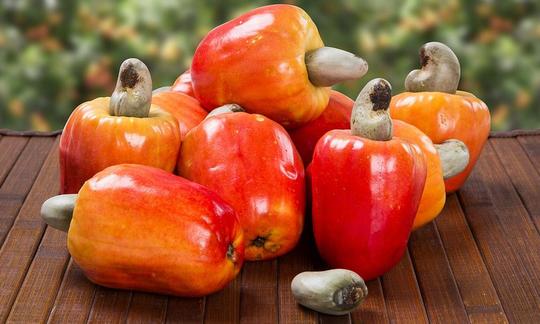

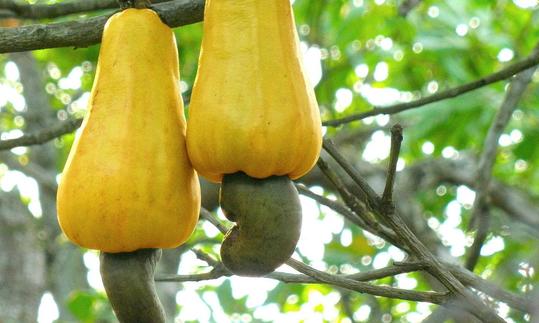

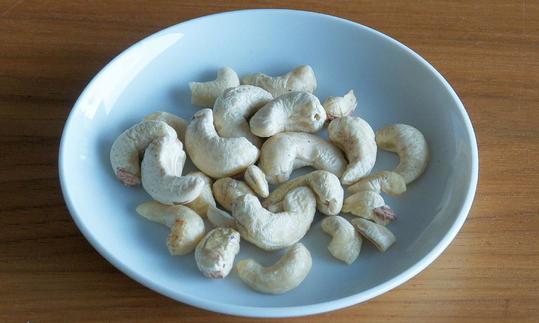

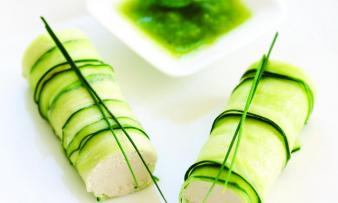
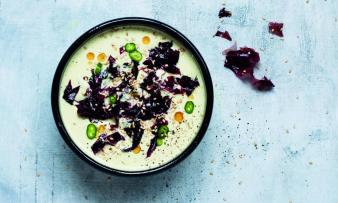
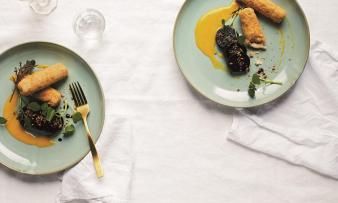


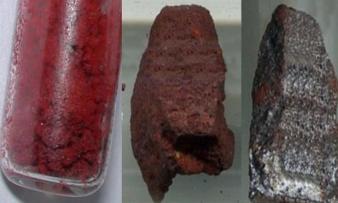


Comments